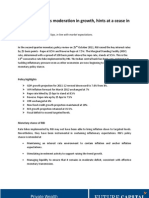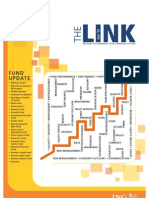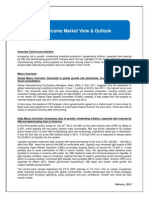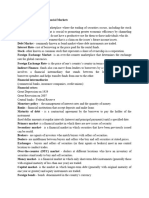Yield Curves Are Not Toeing RBI's Line
Yield Curves Are Not Toeing RBI's Line
Uploaded by
Sandip RoyCopyright:
Available Formats
Yield Curves Are Not Toeing RBI's Line
Yield Curves Are Not Toeing RBI's Line
Uploaded by
Sandip RoyCopyright
Available Formats
Share this document
Did you find this document useful?
Is this content inappropriate?
Copyright:
Available Formats
Yield Curves Are Not Toeing RBI's Line
Yield Curves Are Not Toeing RBI's Line
Uploaded by
Sandip RoyCopyright:
Available Formats
Moneycontrol.
com
http://www.moneycontrol.com/india/newsarticle/news_print.php?autono...
Print This Pa Yield curves are not toeing RBI's line
Yield curves are not toeing RBI's line of inflation rising and growth remaining steady. The current flat to inverted shape of the yield curve across fixed income securities, suggest that both inflation and growth will come off. RBI in its policy review in July raised the repo rate by a higher than expected 50bps to bring down rising inflation expectations. The RBI raised March 2011 forecast for inflation by 1% from 6% to 7% while maintain GDP growth forecast at around 8% levels. Yield curve is the plotting of yields across maturities of bonds having similar credit characteristics. The government bond yield curve, the corporate bond yield curve and the interest rate swap yield curve are all flat to inverted. The normal theoretical shape of the yield curve is upward sloping as investors demand higher yields for longer maturity bonds to counter inflation risks in the longer term. Yield curves in a growth economy are typically upward sloping as bond investors factor in growth led inflation in long bond yields. The move away from normal implies that fixed income investors are not demanding higher yields for longer maturity bonds to compensate for inflation risks. In fact the sharp inversion in the interest rate swap curve suggest that RBI will actually start cutting policy rates in the first half of fiscal 2012-13. The charts below show the shape of yield curves for government bonds, AAA rated corporate bonds and OIS (Overnight Index Swap yields) Government bond yield curve (Chart 1) (Source: CCIL) AAA corporate bond yield curve (Chart 2) (Source: CCIL) OIS yield curve (Chart 3) (Source: CCIL)
The one year, five year and ten year maturity government bond yields are all trading between 8.4% to 8.5% levels. The yield curve is flat for government bonds. The government is borrowing Rs 12,000 crores on a weekly basis with issues being concentrated in the ten and eleven year segment of the yield curve. The market is buying ten year government bonds at almost the same yield as of the one year government bonds. One year yields are reflecting RBI rate hikes and
1 of 2
11/08/03 8:57 PM
Moneycontrol.com
http://www.moneycontrol.com/india/newsarticle/news_print.php?autono...
tight liquidity situation (market is borrowing from the RBI at repo rates of 8% on a daily basis). Ten year yields, while trading at multi year highs, are reflecting inflation coming off down the line as investors demand for ten year bonds in the auctions are steady. Corporate bonds are trading at around 9.5% levels for two, five and ten year maturity bonds while one year corporate bonds are trading at 9.7% levels. One year corporate bond rates at 9.7% levels reflect tight liquidity conditions. Investors are buying five and ten year corporate bond yields at 9.5% levels indicating that absolute levels of yields at the longer end of the curve are attractive. Investors hope to gain from yields trending down at the longer end of the corporate bond curve. The swap market is more conclusive in its judgment of inflation. Five year OIS (Overnight Index Swap) yields are trading at 80bps below one year OIS yields. In fact after the policy rate hike by 50bps, five year OIS yields closed the week at levels below pre policy levels. Five year OIS yields are trading at below 8.5% levels while one year OIS yields are trading at 8.3% levels. One year swap yields are betting on the RBI continuing its tight money policy while five year swap yields are indicating that RBI by tightening in the short term is setting up conditions to start loosening monetary policy in the longer term. The market seems to have more faith in the RBI than RBI itself. If the market was worried on inflation overshooting targets, yields curves will be steep with long maturity bonds and swaps trading at levels much higher than short maturity bonds and swaps. The last time the yield curve was inverted was just before the credit crisis hit the market in 2008. Post the crisis, bond yields came, inflation fell and growth came off. RBI had hiked policy rates sharply to bring down inflation expectations which, were trending at over double digit levels in mid 2008. Repo rates were at 9% levels before coming down all the way down to 4.75% as the RBI cut rates on falling inflation and growth expectations. Yield curves at present are factoring in a similar situation down the line. Arjun Parthasarathy is the Editor of investorsareidiots.com, a web site for investors.
2 of 2
11/08/03 8:57 PM
You might also like
- Fitting The Yield Curve and Cubic Spline InterpolationNo ratings yetFitting The Yield Curve and Cubic Spline Interpolation36 pages
- RBI Policy Review Oct 2011 Highlights and RecommendationNo ratings yetRBI Policy Review Oct 2011 Highlights and Recommendation7 pages
- Annual Report For Policy Holders Economic Update20170824 071040No ratings yetAnnual Report For Policy Holders Economic Update20170824 0710404 pages
- Monetary Policy and Role of Banks: February 2015No ratings yetMonetary Policy and Role of Banks: February 20157 pages
- Icici Prudential Mutual Fund Rbi Second Quarter Review of Monetary Policy 2010-11No ratings yetIcici Prudential Mutual Fund Rbi Second Quarter Review of Monetary Policy 2010-114 pages
- C O M P A N Y P R O F I L E: Achal Gupta Managing Director & Chief Executive OfficerNo ratings yetC O M P A N Y P R O F I L E: Achal Gupta Managing Director & Chief Executive Officer61 pages
- A Study On The Impact of RBI Monetary Policies On Indian Stock MarketNo ratings yetA Study On The Impact of RBI Monetary Policies On Indian Stock Market63 pages
- Debt Mutual Fund Picks: Macro Data Round UpNo ratings yetDebt Mutual Fund Picks: Macro Data Round Up6 pages
- Week Ended September 21, 2012: Icici Amc Idfc Amc Icici BankNo ratings yetWeek Ended September 21, 2012: Icici Amc Idfc Amc Icici Bank4 pages
- RBI Springs Surprise, Cuts Repo by 50 Bps by Dinesh Unnikrishnan & Anup RoyNo ratings yetRBI Springs Surprise, Cuts Repo by 50 Bps by Dinesh Unnikrishnan & Anup Roy5 pages
- Structure of Interest Rate in India: Dr. Anil KumarNo ratings yetStructure of Interest Rate in India: Dr. Anil Kumar4 pages
- What is the Current State of the Indian EconomyNo ratings yetWhat is the Current State of the Indian Economy22 pages
- CETKing Study3 Report RBI S Monetary PolicyNo ratings yetCETKing Study3 Report RBI S Monetary Policy8 pages
- Indian Monetary Policy Analysis (2010-2017)95% (21)Indian Monetary Policy Analysis (2010-2017)38 pages
- RBI Raised Interest Rates How This Impacts You!No ratings yetRBI Raised Interest Rates How This Impacts You!5 pages
- Indian Rupee Vs US Dollar Exchange RatesNo ratings yetIndian Rupee Vs US Dollar Exchange Rates3 pages
- Financial Soundness Indicators for Financial Sector Stability in BangladeshFrom EverandFinancial Soundness Indicators for Financial Sector Stability in BangladeshNo ratings yet
- AAIB Fixed Income Fund (Gozoor) : Fact Sheet FebruaryNo ratings yetAAIB Fixed Income Fund (Gozoor) : Fact Sheet February2 pages
- Chapter 3 - Structure of Interest RatesNo ratings yetChapter 3 - Structure of Interest Rates34 pages
- Topic 59 Spot, Forward, and Par Rates - AnswersNo ratings yetTopic 59 Spot, Forward, and Par Rates - Answers11 pages
- The GIC Weekly: Change in Rates or Rates of Change?No ratings yetThe GIC Weekly: Change in Rates or Rates of Change?14 pages
- A Project Work Report Proposal: A Study Analysis On The Interested of Nepal Bank LimitedNo ratings yetA Project Work Report Proposal: A Study Analysis On The Interested of Nepal Bank Limited7 pages
- A01 Summer Training Project Report: Marketing MixNo ratings yetA01 Summer Training Project Report: Marketing Mix56 pages
- Cvitani J., Zapatero F. - Introduction To The Economics and Mathematics of Financial MarketsNo ratings yetCvitani J., Zapatero F. - Introduction To The Economics and Mathematics of Financial Markets515 pages
- Iefinmt Reviewer For Quiz (#2) : I. IdentificationNo ratings yetIefinmt Reviewer For Quiz (#2) : I. Identification9 pages
- Get (Ebook PDF) Investments: An Introduction 13th Edition PDF Ebook With Full Chapters Now100% (5)Get (Ebook PDF) Investments: An Introduction 13th Edition PDF Ebook With Full Chapters Now41 pages
- [Ebooks PDF] download (eBook PDF) Fundamentals of Investing, Global Edition 14th Edition full chapters100% (1)[Ebooks PDF] download (eBook PDF) Fundamentals of Investing, Global Edition 14th Edition full chapters55 pages
- IQ Test Your Investment Quotient Exercises100% (2)IQ Test Your Investment Quotient Exercises40 pages
- Multiple Choice Questions: How To Value Bonds and StocksNo ratings yetMultiple Choice Questions: How To Value Bonds and Stocks31 pages

























































































